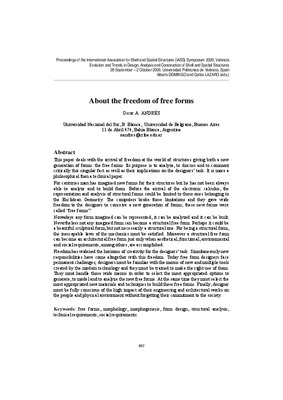JavaScript is disabled for your browser. Some features of this site may not work without it.
Buscar en RiuNet
Listar
Mi cuenta
Estadísticas
Ayuda RiuNet
Admin. UPV
About the freedom of free forms
Mostrar el registro sencillo del ítem
Ficheros en el ítem
| dc.contributor.author | ANDRES, Oscar A.
|
|
| dc.contributor.editor | Domingo Cabo, Alberto
|
es_ES |
| dc.contributor.editor | Lázaro Fernández, Carlos Manuel
|
es_ES |
| dc.date.accessioned | 2010-01-26T13:17:06Z | |
| dc.date.available | 2010-01-26T13:17:06Z | |
| dc.date.issued | 2010-01-26T13:17:06Z | |
| dc.identifier.isbn | 978-84-8363-461-5 | |
| dc.identifier.uri | http://hdl.handle.net/10251/6956 | |
| dc.description | p. 907-913 | en_EN |
| dc.description.abstract | This paper deals with the arrival of freedom at the world of structures giving birth a new generation of forms: the free forms. Its purpose is to analyze, to discuss and to comment critically this singular fact as well as their implications on the designers' task. It is more a philosophical than a technical paper. For centuries man has imagined new forms for their structures but he has not been always able to analyze and to build them. Before the arrival of the electronic calculus, the representation and analysis of structural forms could be limited to those ones belonging to the Euclidean Geometry. The computers broke those limitations and they gave wide freedom to the designers to conceive a new generation of forms; these new forms were called "free forms". Nowadays any form imagined can be represented, it can be analyzed and it can be built. Nevertheless not any imagined form can become a structural free form. Perhaps it could be a beautiful sculptural form, but not necessarily a structural one. For being a structural form, the inescapable laws of the mechanics must be satisfied. Moreover a structural free form can become an architectural free form just only when aesthetical, functional, environmental and social requirements, among others, are accomplished. Freedom has widened the horizons of creativity for the designers' task. Simultaneously new responsibilities have come altogether with this freedom. Today free form designers face permanent challenges; designers must be familiar with the menus of new and multiple tools created by the modern technology and they must be trained to make the right use of them. They must handle those wide menus in order to select the most appropriated options to generate, to model and to analyze the new free forms. At the same time they must select the most appropriated new materials and techniques to build these free forms. Finally, designer must be fully conscious of the high impact of their engineering and architectural works on the people and physical environment without forgetting their commitment to the society. | en_EN |
| dc.language | Inglés | en_EN |
| dc.publisher | Editorial Universitat Politècnica de València | es_ES |
| dc.relation.ispartof | Symposium of the International Association for Shell and Spatial Structures (50th. 2009. Valencia). Evolution and Trends in Design, Analysis and Construction of Shell and Spatial Structures : Proceedings | en_EN |
| dc.rights | Reserva de todos los derechos | en_EN |
| dc.subject | Free forms | en_EN |
| dc.subject | Morphology | en_EN |
| dc.subject | Morphogenesis | en_EN |
| dc.subject | Form design | en_EN |
| dc.subject | Structural analysis | en_EN |
| dc.subject | Technical requirements | en_EN |
| dc.subject | Social requirements | en_EN |
| dc.title | About the freedom of free forms | en_EN |
| dc.type | Comunicación en congreso | en_EN |
| dc.rights.accessRights | Abierto | es_ES |
| dc.description.bibliographicCitation | Andres, OA. (2010). About the freedom of free forms. Editorial Universitat Politècnica de València. http://hdl.handle.net/10251/6956 | es_ES |
| dc.relation.conferencename | Symposium of the International Association for Shell and Spatial Structures | es_ES |
| dc.relation.conferencedate | 2009 | es_ES |
| dc.relation.conferenceplace | Valencia | es_ES |






